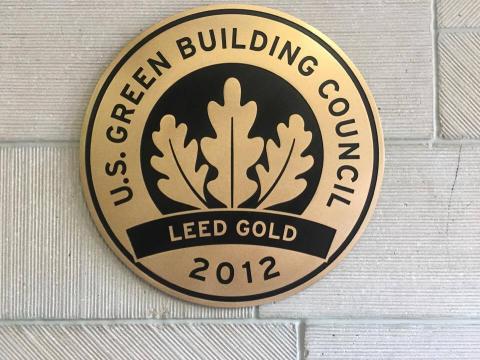Designing a Sustainable Campus

Florida State University’s campus is a student sanctuary of red-bricked buildings, freshly mowed lawns, and abundant foliage. From Dodd Hall’s philosophical quotes and grand entrances to the libraries’ cozy chairs and quiet areas, the campus buildings speak with wisdom and offer comfort.
These beautiful buildings give our campus more than just aesthetics. One building's natural light illuminates our books of knowledge while simultaneously conserving resources, and another contains colorful walls that provide cleaner air. As we enter these doors and sit in these chairs, we are in the midst of sustainable design. A design with purpose.
Sustainability at Florida State can be found in outward facing installations like water-saving hydration stations or solar umbrellas that charge your phone.
A building’s internal sustainability, however, isn't always as apparent.
The William Johnston building, for example, was certified as a Leadership in Energy and Environmental Design (LEED) Gold building in 2009 through FSU’s Design and Construction Department (https://www.facilities.fsu.edu/depts/designConstr/greenBuildings.php). It diverted 75 percent of construction waste from the landfill, uses natural lighting and daylight sensors, and manages the roof heat island effect to reduce energy needs and costs for air conditioning.The King Life Sciences building contains low flow fixtures for water conservation and low emitting paint, carpet, and coatings.
FSU utilizes the latest versions of LEED and works continuously to improve buildings’ energy and water efficiency, healthy interior and exterior environments, and long building life. “Our buildings are meant to last a lifetime, so we’re approaching design and construction holistically in order to be good stewards of the environment,” said Kimberly Ball, Senior Construction Specialist and LEED AP of FSU Facilities Design and Construction.
It’s common to roam FSU’s halls on your way to the laboratory or group study, without realizing that the design around us has intention.
This sustainable design intention is being taught right here at FSU.
“Students are learning how to evaluate the human experience within a building through characteristics, such as light, air, views, acoustics, fitness, and comfort,” said Dr. Lisa Waxman, professor and chair of FSU’s Department of Interior Architecture and Design. “We are investigating and applying LEED criteria [to our projects], such as community connectivity, water efficiency, the use of smart materials and resources, and indoor environmental quality.”
Dr. Lisa Waxman, who is a LEED accredited professional, instructs students on how to employ sustainability in their design plans, as well as how to incorporate LEED criteria and WELL Building standards (https://www.wellcertified.com/) into their projects.
For instance, students investigate transportation methods and available resources within a given area to understand a community’s ability to travel throughout a city efficiently, which helps students determine a building location. Students are also taught how to explore the use of reclaimed materials, which lessens the impact on the environment and species health.
“Engineers and architects help shape the building, but when it comes to what you are touching and personally experiencing in a space, interior designers have a huge role to play in that aspect of design,” said Waxman.
She believes that sustainable design is gaining significant momentum and that implementing design practices, like rooftop gardens and solar, can improve our quality of life and reduce our contribution to greenhouse gas emissions. As FSU continues to build sustainably, we are committing to the health and prosperity of future generations. “There is a lot of great thinking and effort going on at FSU right now,” said Waxman.
Enhancing our awareness of sustainable design can lead to substantial, positive effects on human and environmental health. All professionals involved in the design of the built environment have a role to play in creating sustainable spaces. FSU interior architecture and design students are preparing to take their place in a profession that cares about the planet and the human experience.
Savannah Rodrigue, a senior at Florida State University, works in the FSU Sustainable Campus office as a Communications Assistant. FSU is a member of the Capital Area Sustainability Council (CASC), a forum organized by Sustainable Tallahassee to bring together organizations that have a community wide sphere of positive influence on sustainability; CASC brings you “Greening Our Community” articles. Learn more at www.SustainableTallahassee.org/CASC.
